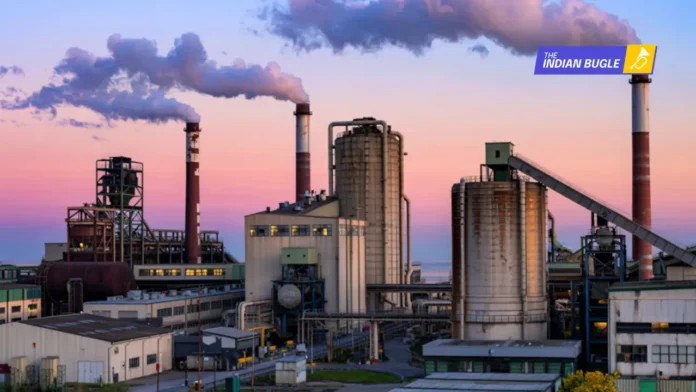As the winter season sets in, Delhi’s air quality has once again plunged into the ‘poor to inferior’ category, with the Air Quality Index (AQI) hovering between 280 and 320 across most parts of the city. Areas like Anand Vihar, Jahangirpuri, and Rohini are recording some of the worst pollution levels, while visibility in the early morning hours has significantly dropped due to smog accumulation.
The main causes behind the worsening pollution this year include:
- Stubble burning in Punjab and Haryana: Satellite data indicate a rise in farm fires as farmers prepare for the next sowing season. The smoke drifts toward the capital due to northwesterly winds.
- Vehicular emissions: With over 1.4 crore vehicles registered in the Delhi-NCR region, traffic congestion remains one of the major contributors to PM2.5 and PM10 emissions.
- Construction and road dust: Despite construction bans in sensitive zones, dust from large-scale infrastructure projects continues to worsen particulate levels.
- Calm wind conditions: During October and November, wind speeds remain low, trapping pollutants near the surface and preventing natural dispersion.
- Household and industrial emissions: Use of solid fuels, open garbage burning, and industrial waste release add to the toxic mix.
The thick haze covering Delhi in recent days has revived discussions on emergency anti-pollution measures, including the odd-even vehicle scheme, firecracker bans, and now, cloud seeding — a scientific approach to induce artificial rain and temporarily clean the air.
What is Cloud Seeding?
Cloud seeding is a weather modification process that involves dispersing substances such as silver iodide, sodium chloride, or potassium iodide into clouds to stimulate rainfall. These substances act as nuclei around which water droplets condense, increasing the likelihood of precipitation.
This can be done through aircraft, drones, or ground-based generators. However, it only works when clouds have enough moisture, vertical depth, and the right temperature profile. Scientists estimate that under ideal conditions, cloud seeding can enhance rainfall by 10–20%.
How Cloud Seeding Can Help Delhi’s Pollution Problem
With pollution levels climbing to hazardous levels every winter, cloud seeding is being viewed as a short-term emergency solution to provide temporary relief from the thick blanket of smog.
Potential Benefits:
- Rain-Induced Washout: Artificial rain can wash out fine dust, particulate matter, and toxic pollutants from the air, improving AQI for a few hours or even a day or two.
- Cooling and Psychological Relief: A brief spell of rain can reduce surface temperatures and provide much-needed comfort to residents affected by respiratory distress and eye irritation.
- Scientific Data for Policy: The pilot can offer valuable data on the correlation between artificial rainfall and pollution reduction, shaping future weather-modification policies.
Key Limitations:
- Dependence on Weather: Cloud seeding cannot be performed in dry or cloudless conditions, which often coincide with Delhi’s worst pollution episodes.
- Temporary Solution: Even if rainfall helps clear the air, pollutants return quickly if emissions from vehicles, industries, and crop burning continue.
- High Costs: Each seeding sortie involves significant expense, and its effectiveness is not guaranteed without ideal atmospheric conditions.
Environmental and Health Impact
Cloud seeding has been tested in several countries and is generally regarded as safe when executed responsibly.
Key Points:
- The chemicals used (such as silver iodide and salt) are released in very small amounts that do not harm soil, plants, or water bodies.
- The rainwater from seeding is safe for humans, animals, and crops.
- Continuous monitoring ensures no chemical accumulation over repeated operations.
However, experts recommend careful long-term monitoring, especially if cloud seeding becomes a recurring practice, to avoid potential ecological buildup of silver compounds.
How Delhi’s Cloud Seeding Pilot Works
- Lead Agency: IIT Kanpur, in collaboration with the Delhi Government and IMD.
- Technology: A Cessna aircraft equipped with silver iodide and salt flares.
- Flight Duration: About 1–1.5 hours per sortie, covering up to 100 sq km per operation.
- Execution Window: Flights will only take place when IMD identifies seedable clouds.
- Impact Measurement: Pollution levels (PM2.5 and PM10) will be tracked through real-time air quality monitoring before and after rainfall.
What to Expect
Best-Case Scenario:
If conditions align, cloud seeding could produce light rainfall over Delhi, helping wash away particulate matter and offering temporary but noticeable relief from smog.
Typical Outcome:
Limited or no rainfall if clouds are too thin or dry, making the operation less effective.
Long-Term Reality:
Cloud seeding is not a sustainable pollution-control method. It can complement, but not replace, essential measures like switching to clean energy, improving waste management, regulating industrial emissions, and encouraging green transport.
As Delhi grapples with choking air and rising pollution levels, cloud seeding presents a ray of hope, offering temporary relief through artificial rainfall. However, experts caution against viewing it as a permanent fix.
While a few showers may clear the skies briefly, the only lasting solution lies in reducing emissions, managing waste, controlling stubble burning, and transitioning to sustainable urban planning.
Delhi’s 2025 cloud seeding project represents a technological experiment and a wake-up call — that the fight for clean air must go beyond clouds and into policy, awareness, and long-term action.
